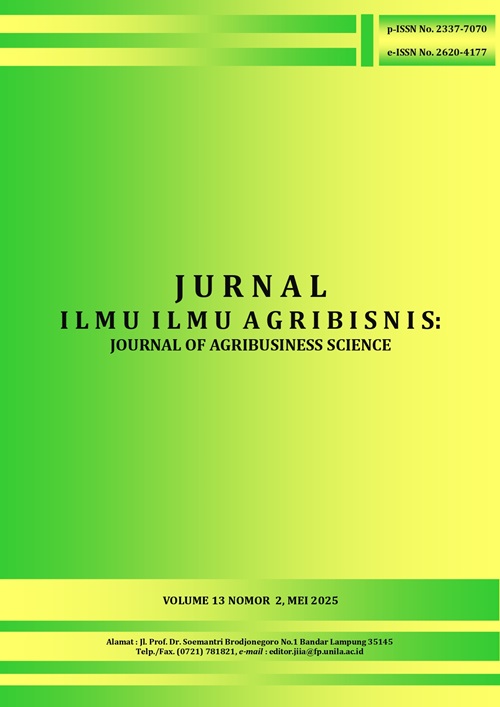ANALISIS EFISIENSI PRODUKSI USAHATANI CABAI MERAH DI PROVINSI LAMPUNG
DOI:
https://doi.org/10.23960/jiia.v13i2.9666 Abstract View: 190
Abstract View: 190
Abstract
The aim of this research is to analyze technical efficiency and technical inefficiency, profitability and income of red chili cultivation businesses in Lampung province. This research was carried out in South Lampung and Pesawaran Regencies. Respondents were identified using a simple random sampling method from a total of 67 chili producers. Survey data was collected from October to December 2023. Technical efficiency and inefficiency were analyzed using the stochastic frontier method, efficiency was analyzed using the dual marginal cost function method, and agricultural productivity was calculated using agricultural income analysis. The research results show that red chili producers in Lampung Province are technically efficient, with an efficiency score 94.10%. Factors that influence the technical inefficiency of red chili cultivation are age, number of family members and farming experience. The profitability of growing chilies is less than 10%. The monetary income from cultivating red chilies in Lampung Province is IDR 29,595,410/0.28 ha and the R/C value of monetary costs is 3.3. Total income from red chili cultivation is IDR 26,203,341/0.28 ha with an R/C value of 2.5. It means that planting red chilies in Lampung Province is profitable.
Keywords: Efficiency, farming, red chili
Downloads
Downloads
Published
How to Cite
Issue
Section
License
Authors who publish with this journal agree to the following terms:
Authors retain copyright and grant the journal right of first publication with the work simultaneously licensed under a Creative Commons Attribution License that allows others to share the work with an acknowledgement of the work's authorship and initial publication in this journal.
Authors are able to enter into separate, additional contractual arrangements for the non-exclusive distribution of the journal's published version of the work (e.g., post it to an institutional repository or publish it in a book), with an acknowledgement of its initial publication in this journal.
Authors are permitted and encouraged to post their work online (e.g., in institutional repositories or on their website) prior to and during the submission process, as it can lead to productive exchanges, as well as earlier and greater citation of published work (See The Effect of Open Access).














